The ‘Fjell’ or ‘Mountain’ Fleet
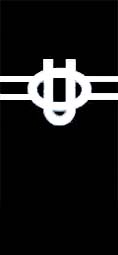
 This well-known Oslo fleet operated for 64 years in a variety of trades including the traditional North Sea and Baltic timber and coal trades, deep sea tramping and tanker trades, the summer Fjell Line from the Great Lakes to European ports, and the winter Jaffa Line trade with fruit from the Eastern Mediterranean to Northern Europe. Kristoffer Olsen and Rudolf Ugelstad began their co-operation in 1915 after previously being friends for a long period of time. Kristoffer Olsen was born in the village of Melsomvik on 8th August 1883 in the Vestfold area to the west of Oslofjord, while Rudolf Thoresius Ugelstad was born on 7th August 1878 and grew up in the town of Brevik in the Telemark area to the west of Vestfold that is now merged with Porsgrunn. Telemark had only a tiny percentage of the population of Norway at this time. The partners both came from seafaring families with long traditions from the sailing ship days, with Rudolf Ugelstad having ambitions to become a shipowner in the period just before the outbreak of World War I.
This well-known Oslo fleet operated for 64 years in a variety of trades including the traditional North Sea and Baltic timber and coal trades, deep sea tramping and tanker trades, the summer Fjell Line from the Great Lakes to European ports, and the winter Jaffa Line trade with fruit from the Eastern Mediterranean to Northern Europe. Kristoffer Olsen and Rudolf Ugelstad began their co-operation in 1915 after previously being friends for a long period of time. Kristoffer Olsen was born in the village of Melsomvik on 8th August 1883 in the Vestfold area to the west of Oslofjord, while Rudolf Thoresius Ugelstad was born on 7th August 1878 and grew up in the town of Brevik in the Telemark area to the west of Vestfold that is now merged with Porsgrunn. Telemark had only a tiny percentage of the population of Norway at this time. The partners both came from seafaring families with long traditions from the sailing ship days, with Rudolf Ugelstad having ambitions to become a shipowner in the period just before the outbreak of World War I.
The shipowning plans of Rudolf Ugelstad took a step forward in early 1915, when he and Kristoffer Olsen agreed to buy an old barque named Superb, and had her cut down into a barge for carrying cargoes of timber across the North Sea, returning with coal and coke. The tug Loeko was chartered for the job of towing, and this was so successful that five more small barques were purchased by the end of 1915 and cut down for use as barges. A Dutch engines aft coaster of 400 dwt was purchased as Zeester and renamed Filefjell for towing the barges, and a former British trawler built at the yard of Cook, Welton & Gemmell at Beverley was also converted into a towing vessel and renamed Veslefjell. However, the slow towing speed made them vulnerable to the fleets of German U-boats operating in the North Sea, with five of the six barges sunk during 1915 and 1916.

Steamship Company A/S Rudolf
Olsen & Ugelstad & Company was established on 29th March 1915 by Kristoffer Olsen, Rudolf Ugelstad and C. Herman Jensen. When the third Jensen partner was bought out by the two other partners a few months later on 8th July 1915, he withdrew to leave a partnership renamed as Olsen & Ugelstad. The Swedish steamer Smaland of 1,400 dwt, built by the Wood, Skinner yard in Gateshead as Skeffington in 1893 for J.O. Scott of Newcastle, was purchased on 25th March 1915 for A/S Rudolf with an initial capital of 255,000 Norwegian kroner, increased to 400,000 Norwegian kroner in June 1915. The steamer was renamed Rudolf and was registered at first at Fredrikstad, where Rudolf Ugelstad had once lived, but four days later it was re-registered at Oslo by a magistrate in the capital. Four further steamers were purchased in 1915 to complete a small fleet of five ships named Rudolf, Taormina of 2,150 dwt, Arena of 1,500 dwt, Egero of 2,000 dwt and Dovrefjell of 2,400 dwt. Egero had been completed in 1883 as Iron Prince for James Knott of North Shields by Swan & Hunter at Wallsend, and Doverejell had been built in 1891 as Cairnglen for Cairns, Young and Noble of Newcastle, while Arena had been completed at Chepstow by Edward Finch & Co. Ltd. for John Cory & Sons Ltd. of Cardiff as Radyr.

The shipbroker Hjalmar Bjorge had helped in the purchase of the steamers, and he became a member of the Norwegian Shipbrokers Association (Norsk Skigsmeglerforbund), and continued as shipbroker to the partnership until his death in 1953. Several steamship companies were formed in 1915, and many more for several years afterwards e.g. A/S Egero with a capital of 250,000 Norwegian kroner on 30th September 1915, A/S Dovrefjell with a capital of 380,000 Norwegian kroner on 22nd October 1915, and A/S Luksefjell with a capital of 500,000 Norwegian kroner in 1916. However, by 1927 the growing fleet was registered only in the ownership of A/S Rudolf, A/S Valberg and A/S Luksefjell. The fleet had a deadweight carrying capacity of 7,700 tonnes at the end of 1916, but numerous war losses were constantly replaced by purchased ships at rapidly increasing ship prices to give a fleet of a dozen steamers of 27,060 dwt at the end of the war in November 1918. Among the war losses were the steamers Arena, Falkefjell, Luksefjell, Lilias, Rutenfjell, Dovrefjell sunk by collision with a British patrol boat off Land’s End on 24th February 1917 while on a voyage from Nantes to Ardrossan with iron ore, and Munter sunk by collision on 5th February 1918 at Berville in the river Seine while on a voyage from Rouen to the Tyne.
Skibs A/S Kingston was acquired by Olsen & Ugelstad in February 1918 for 1.5 million Norwegian kroner and its three steamers Tango, Kingston and Huftero. Tango was sold on in September 1919 to a Haugesund shipowner, while the reefer Kingston of 1,650 dwt was renamed Falkefjell but continued on charter to the Atlantic Fruit Company, half owned by United Fruit of Boston and the di Giorgio group in the U.S.A., until sold in 1924 to Japanese owners. Huftero was renamed Ornefjell and traded until sold in July 1928 to a Risor shipowner.
Four sailing ships were also owned at this time of the end of the sailing ship era, with only the big barques of Gustaf Erikson of Mariehamn in the Aland Islands continuing in the Australian wool and grain trades until World War II. The three masted barque Scottish Glens of 2,116 grt had been built in 1885 by the yard of Oswald, Mordaunt & Company at Woolston in Southampton for W.H. Ross of Liverpool, and was purchased in May 1917 for 850,000 Norwegian kroner. Unfortunately, she was dismasted and lost most of her sailing rig on 20th October 1918 to the north east of Bermuda while on a voyage from Newport News to Rio de Janeiro with coal. She arrived at Barbados on 26th December 1918 under a jury rig and was condemned and sold to insurers. Later in 1922, she was converted into a motor ship fitted with twin four cylinder Atlas diesels and renamed Haugar of 3,450 dwt. The three masted barque Prince George of 1,946 grt had been built at the yard of Thomas Royden & Sons in Liverpool as Callistoga for a Liverpool owner, but was purchased on 21st May 1918 by Olsen & Ugelstad as Prince George and sold on in September 1919. In March 1922, the four masted barque Hafrsfjord of 1,997 grt and the three masted full rigger Kalliope of 1,664 grt were purchased en-bloc from A.F. Klaveness for 100,000 Norwegian kroner. They remained laid up in Norway until they were sold for breaking up in England in 1924/25 for the combined sum of £5,175.
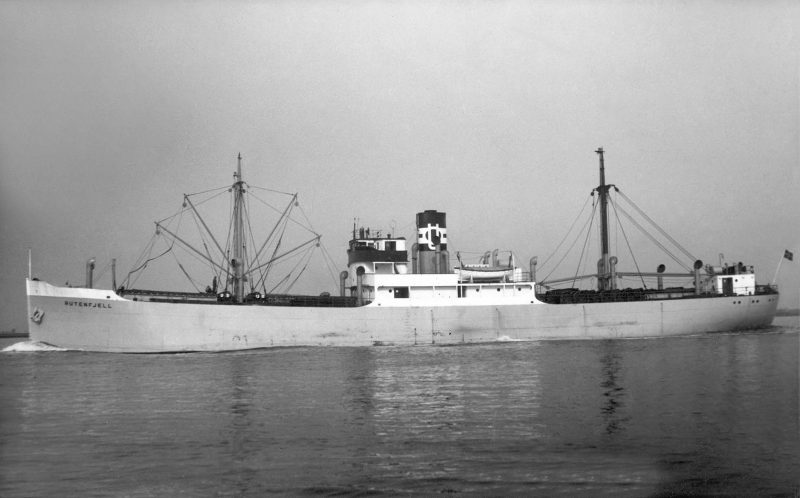
New Trades In The Inter-War Years
The deep sea tramp trades were entered in 1920 when freight rates were at an all time high in the post-war boom, but the subsequent slump by late 1921 saw many Norwegian shipowners go out of business. Olsen & Ugelstad proceeded with extreme caution at this time as they were constrained by the huge financial commitments that had been made during the first World War. A new tramp of 4,120 dwt was completed for the partnership in September 1921 as Haukefjell of 4,120 dwt by the Forth Shipbuilding and Engineering Co. Ltd. at Alloa. The similar sized new tramp Ravnefjell of 4,115 dwt was completed in 1921 and purchased in 1922, and operated alongside the engines aft Jotunfjell of 4,050 dwt and Granli of 3,300 dwt in the deep sea tramp trades. Jotunfjell was an interesting ship with much cargo handling gear on three masts and a set of posts and had been completed in 1915 by the Ashtabula yard of the Great Lakes Engineering Works as Morris Adler. She was purchased in February 1916 and renamed Jotunfjell and was damaged by a torpedo on 20th January 1917 from UC21 near Glenans in France and was towed to Lorient and repaired. She grounded at Vik to the south of Bronnoysund on 19th February 1934 while on a voyage from Blyth to Kirkenes with coal and was refloated with the aid of two salvage tugs. She was repaired and lengthened to 4,750 dwt and renamed Varangfjell in 1934.
Granli had been purchased for 2.4 million Norwegian kroner on 9th October 1917 for A/S Rudolf, but ran aground on 17th August 1926 near Alesund while on a voyage from Bremen to Archangel with coal. She was refloated and sold to insurers but was renamed Harpefjell after repurchase. She had a disastrous fire on 9th December 1933 off Zipnavolok to the north east of Kirkenes while on a voyage from Kovda to the Thames with timber. She was abandoned and capsized and sank upside down, fortunately her crew was rescued. The smaller Tyrifjell disappeared off Kopervik near Haugesund on 8th October 1923 while on a voyage to Antwerp. She had been purchased in 1922 for a small sum as she had been completed fifty years earlier at the Hartlepool yard of Withy, Alexander as Norway for R. Jobson of West Hartlepool. Torefjell of 3,950 dwt had been completed in 1902 by the Grangemouth and Greenock Dockyard at Greenock as Baltique for J. Roy of Rouen, and was purchased four years later by Fred Olsen. Olsen & Ugelstad purchased her in 1924 for A/S Luksefjell, but she was posted as missing on 26th December 1930 after passing Helsingborg while on a voyage from Gydnia to Harstad with coal and coke, some of her remains were found at Egeroy Lighthouse.

The petroleum trades were entered in 1927 as world oil consumption had quadrupled from 1913. The oil majors had rapidly built up their owned fleets, but were aware of the advantages of having a large chartered fleet at their disposal from time to time. The Anglo-Saxon Petroleum Co. Ltd. of London announced a scheme in 1926 whereby they were prepared to sell and charter back 28 war built tankers. All save two tankers were sold to Norwegian shipowners with many later leading shipowners featured in the ‘Sale and Charter Back’ scheme, including Martin Mosvold, Sigurd Herlofsen, Thorvald Brovig, Iver Bugge, Christian Evensen, A. O. Andersen, T. Lodding, E. Hansen-Tangen, J. W. Prebensen, Carl Olsen, Jorgen P. Jensen and others. Olsen & Ugelstad were among the first of these Norwegian shipowners to avail themselves of the scheme, purchasing the steam tanker Lacuna of 9,160 dwt and renaming her Dovrefjell in 1927. Five further tankers were then purchased or completed for the partnership in the years leading up to World War II in Filefjell of 12,450 dwt in 1930 (but had been completed in 1927), Falkefjell of 12,430 dwt in 1931, Fagerfjell of 12,565 dwt in 1935, James Hawson of 9,448 dwt in 1935 (completed as Kim in 1930), and Jotunfjell of 12,670 dwt in 1937.
In 1934, Olsen & Ugelstad owned fifteen steamers in twelve dry cargo ships of Frisco, Glitrefjell, Haukefjell, Harpefjell, Jotunfjell, Luksefjell, Makefjell, Ornefjell, Ravnefjell, Rutenfjell, Rudolf and Vardefjell under three steamship companies A/S Rudolf, A/S Luksefjell and A/S Valberg, as well as three tankers in Dovrefjell, Falkefjell and Filefjell. Six of the dry cargo ships were engines aft bridge ‘midships sisters of 2,400 dwt completed by the Porsgrunn Mek Verksted yard between 1929 and 1934 as Ornefjell, Luksefjell, Vardefjell, Makefjell, Rutenfjell and Glitrefjell. They voyaged to the Mediterranean, the St. Lawrence, as well as to Tenerife and the Canary Islands for potatoes and bananas. Rutenfjell was completed in May 1933 by the Porsgrunn Mek Verkstead yard, but was wrecked on 5th May 1934 at Cape Egmont on Cape Breton Island while on a voyage from Tofte and Methil to Three Rivers with general cargo. She was refloated on 30th June 1934 and beached at Sydney (NS) and broken up.

The time was ripe for further expansion, and within a year in 1935, ten small cargo-liners of between 2,450 and 2,650 dwt were either in service or building for the new summer Fjell Line service to the Great Lakes, and the winter Jaffa Line service from the Eastern Mediterranean to Northern Europe with fruit. Carmelfjell, Rutenfjell, Harpefjell, Svanefjell, Taborfjell (1), Tindefjell, Ornefjell, Ravnefjell, Taborfjell (2), and Harpefjell alternated between the two trades on an annual basis. Taborfjell (1) of 1936 was sold in November 1937 to Anthony Veder N.V. of Rotterdam. This group were four hold steamers powered by Bauer Wach compound steam engines boosted by a low pressure exhaust turbine. The Great Lakes service was popular with calls at Norwegian, British, German, Dutch, Belgian and French ports, to ports on the estuary of the St. Lawrence as well as Quebec, Montreal and ports on the Great Lakes accessed by the restricted size locks on the Welland Canal between Lake Ontario and Lake Erie. A Canadian shipping company had chartered some of the new fleet before the regular ‘Fjell Line’ service started. The funnel colours of the Fjell Line and Jaffa Line ships were yellow with a central black band having the ‘OU’ monogram intersecting two narrow white bands, whereas the remainder of the fleet had black funnels with the white ‘OU’ monogram intersecting two narrow white bands, hulls being grey with red boot topping.
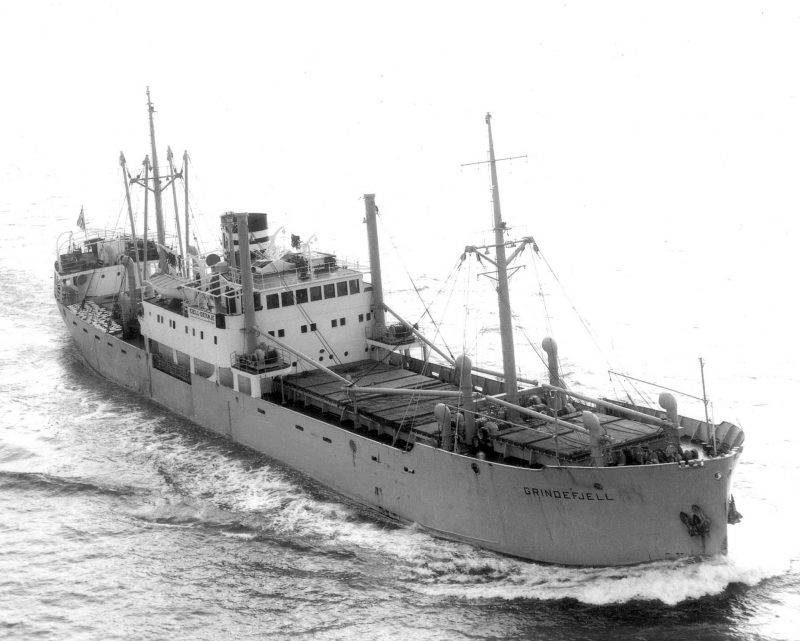
World War II
The Olsen and Ugelstad fleet on the outbreak of war in September 1939 comprised sixteen ships of 90,000 dwt, with four tankers and twelve dry cargo ships. The war hit the company hard, losing five ships and 34 Norwegian seafarers, with those vessels outside Norway on the invasion of their country on 9th April 1940 by Germany coming under the control of Nortraship, the Norwegian Shipping and Trade Mission, set up in London on 25th April 1940. Several of the Home fleet came under German control including the tramp Haukefjell of 4,120 dwt, and she was used by Germany throughout the war, hoisting the German flag in 1944. She was then badly damaged by Allied bombing on 24th February 1945 with her stern section beached in a submerged state at Hamburg. The other part of the ship was raised and broken up in 1946.
Glitrefjell was torpedoed and sunk by U59 on 16th December 1939 off St. Abbs Head while on a voyage from Oslo to the Tyne to load coal. Filefjell was captured and sunk by the surface raider Pinguin on 26th August 1940 when 350 miles south east of Madagascar while on a voyage from Abadan to Table Bay and the U.K. with aviation spirit. She was the second victim of the twenty five ships captured by Pinguin during her successful raiding cruise of twenty two months. Filefjell was sunk the following day with her 32 crew members later reaching France as prisoners of war.
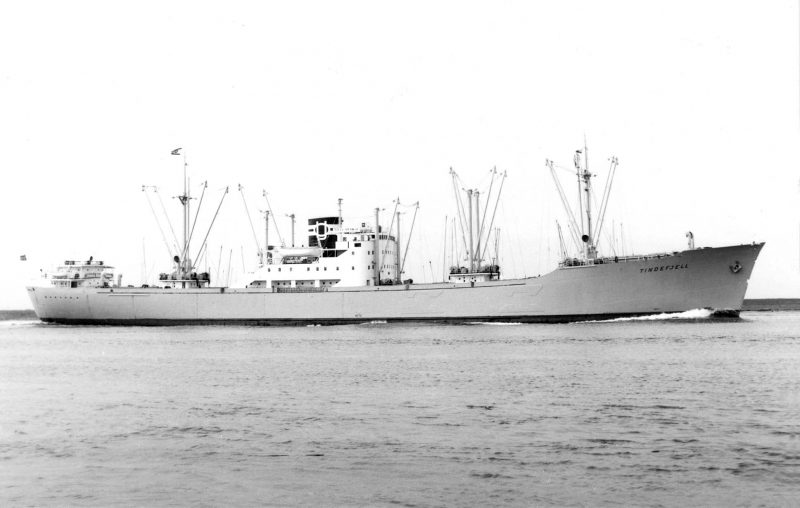
Rutenfjell was detained at Dakar along with twenty five other Norwegian ships when Vichy France took control of the port in June 1940. On 30th April 1941 she was put back into service by the Vichy French as Sainte Brigitte, but was recovered at Dakar in late 1943 when the port changed alliance to General de Gaulle. While in Transatlantic convoy SC2 on 9th September 1940, the Master of Makefjell, Capt. Oywind Meitzner, believed he had rammed and sunk U47, commanded by the fearless Gunther Prien, but in fact it was a ‘near miss’ and the submarine escaped with the loss of six of her crew that were left behind on the conning tower when she crash dived.
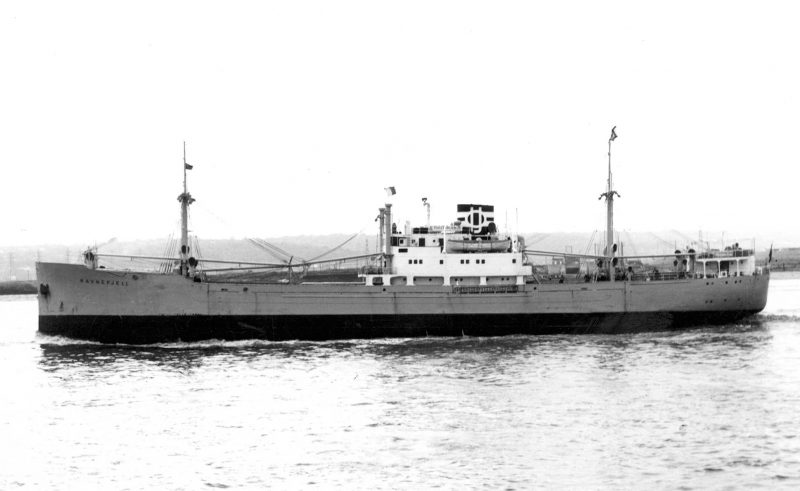
The fully laden new tanker Vardefjell sailed in convoy KMS5 for Operation Torch, the invasion of North Africa, but broke in two on 13th December 1942 in rough weather off the Faroes. The fore part drifted off and was lost, while the stern part made port at Kirkwall by sailing backwards and was then towed to the Tyne for rebuilding with a new forepart. Taborfjell was sunk to the east of Cape Cod by U576 on 30th April 1942 while on a voyage from Matanzas (Cuba) and New York to Montreal with sugar, seventeen crew members were lost. However, on the other hand, some seafarers had a ‘good war’, with the crew of the tanker Falkefjell coming through the war unscathed after some exciting episodes while serving in every ocean of the world, including a six month charter to the Australian Navy.
Post-War Years
The survivors were joined in the Autumn of 1945 by three war built ships, with one ‘Empire’ dry cargo ship of 10,000 dwt in Kronprinsen laid down as Empire Fairbairn at the Barclay, Curle yard on the Clyde but completed as one of twenty tramps and tankers that were handed over to the Norwegian Government for operation. Two were tankers, Empire Druid of the ‘Norwegian’ type of 14,480 dwt built by Laing at Sunderland, was renamed Haukefjell, while Dovrefjell of 15,430 dwt had lain incomplete at the Eriksberg yard at Gothenburg for five years from 1940 until completion in 1945. The German general cargo ship Drau of 3,326 grt had been launched in 1940 for Norddeutscher Lloyd, and became Sperrbrecher 33 on completion in 1944, and was initially given to the U.S.A. as war reparations in 1945. She became Sunni under the Norwegian flag in 1948 and was purchased by Olsen & Ugelstad in 1949 and renamed Tindefjell.

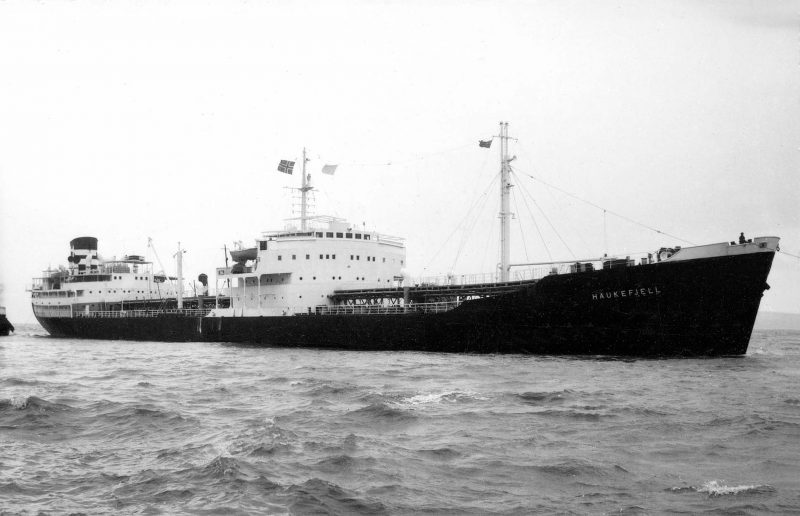
The founder, Kristoffer Olsen, died on 4th August 1948, with his son of the same name made a partner in 1951 under powers delegated to him by his mother, Dagny Marie Olsen, who later died in 1970. Rudolf Ugelstad died on 7th November 1962 in Baerum, with his sons Rolf Ugelstad and Trygve Ugelstad made into partners to manage the post-war fleet. Bjarre Jorgensen, Finn Bjerke and shipbroker Karl Jorgen Bjorge were directors, with Olsen and Ugelstad then a leading member of the Norwegian Shipowners Association (Norges Rederiforbund).
Fjell-Oranje Line
Three small four hold engines ‘midships cargo-liners of 3,200 dwt were completed in 1948 for replacement of lost vessels in Hemsefjell, Makefjell and Ternefjell by the John Crown & Sons Ltd. yard at Sunderland. Ternefjell was sunk by collision on 24th May 1953 off Start Point with Dotterel of the British and Continental Steamship Co. Ltd. while on a voyage from Rotterdam to Glasgow with general cargo. A further seven similar ships were completed by the Crown, Fredrikstad Mek Verksted and Kieler Howaldtswerke yards for Fjell Line services between Norway and the Great Lakes during 1951/55. Six of these were engines ‘midships of between 2,800 and 3,000 dwt, completed as Veslefjell, Luksefjell, Grindefjell, Rutenfjell, Ravnefjell and Ternefjell with most lengthened in 1959 to give a better carrying capacity of 3,455 dwt. The odd man out was Svanefjell of 1,600 dwt, which was a three hold engines aft ship from the Van Duivendijk yard at Lekkerkerk in Holland in 1955.
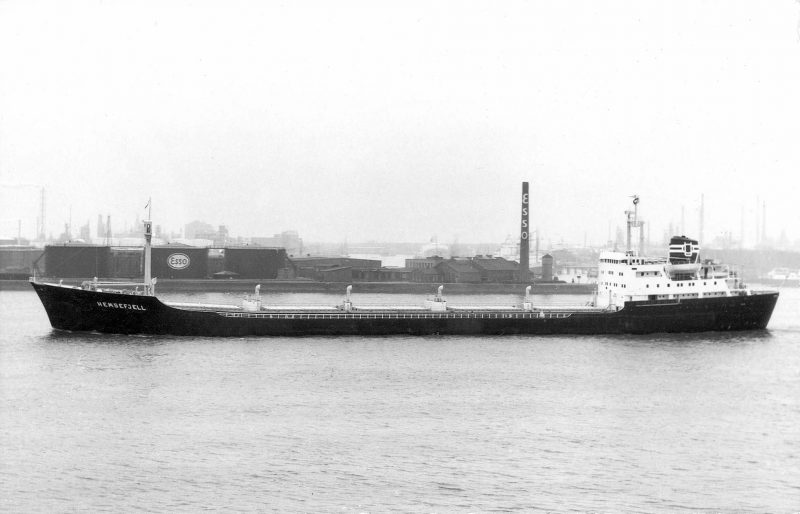
However, a competitor to the Great Lakes services of Fjell Line was making inroads into the trade to Dutch, French and German ports. This was Oranje Line of Anthony Veder of Rotterdam, who had started his service with a few small vessels in 1938 including the purchased Taborfjell and Harpefjell. In February 1956, Fjell Line and Oranje Line petitioned the Federal Maritime Authorities of Canada and the U.S.A. to combine and expand their regular services between the Great Lakes and all of their European ports of call as well as ports in the Mediterranean. A combined fleet of 23 small ships, all bearing ‘Fjell-Oranje Line’ in white on their hulls operated after the April 1959 opening of the enlarged St. Lawrence Seaway with bigger locks on the Welland Canal. Oranje Line through a series of Dutch shipping company mergers was liquidated in 1970, and Olsen and Ugelstad continued the service for two more years with partner Fred. Olsen.
A final cargo-liner operated in the Great Lakes trades during 1970/71, and was an interesting ship in that she was the Fred. Olsen owned Burrard of 11,350 dwt completed in 1956 by the Akers Mek Verksted yard in Oslo. She had six holds served by a dozen derricks on five sets of posts and three electric cranes, and a service speed of 17.5 knots from a powerful Burmeister & Wain diesel engine of 8,600 bhp manufactured by the builder. She was a streamlined ship and a raised quarterdecker on hull dimensions of length 508 feet, moulded beam of 65 feet and depth of thirty feet. She was well known in Vancouver and other west coast Canadian and American ports, as she was often chartered by Westfal-Larsen of Bergen.
She was renamed Ternefjell and then sold on at the end of 1971 to Everett Orient Line for Far East service as Rutheverett.
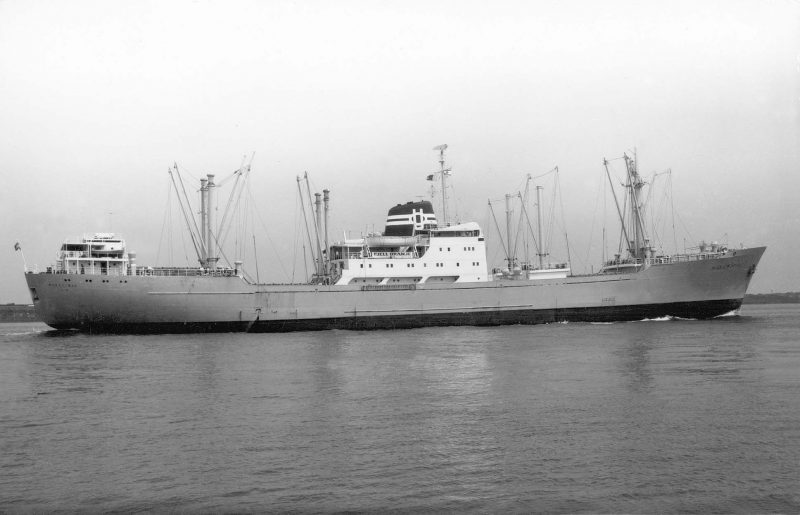
Tankers, Cargo Ships And Bulkers
The tanker fleet was greatly expanded in post-war years with eleven tankers in 1950 out of a reconstructed fleet of twenty ships. The tankers were Dovrefjell of 1945, Etnefjell of 1950, Fagerfjell of 1935, Jotunfjell of 1937, Sognefjell of 1950 and the largest at 24,350 dwt, Falkefjell of 1931, Filefjell of 1948, Haukefjell of 1941, Vardefjell of 1940, Sirefjell of 1936 and Strix of 1930. Tanker sizes crept up rapidly during the 1950s and 1960s with Rondefjell of 22,765 dwt in 1951, Holtefjell of 15,900 dwt in 1952, Fagerfjell of 18,475 dwt in 1953, Haukefjell of 18,250 dwt in 1954, Vardefjell of 18,190 dwt in 1955, Lysefjell of 20,450 dwt in 1957, Hovdefjell of 26,130 dwt in 1958, Haukefjell of 20,250 dwt in 1960, Lysefjell (2) of 20,500 dwt in 1960, sisters Dovrefjell and Falkefjell of 40,400 dwt in 1961, and sisters Vardefjell and Fagerfjell of 59,020 dwt in 1964. Rondefjell was completed for A/S Falkefjell in December 1951, and had acquired the nickname of ‘Half Crown’ ship as her hull was constructed and launched in two halves on 9th April 1951 at the Sunderland yard of John Crown & Sons Ltd., a yard better known for building small ships such as colliers. The two halves were carefully aligned up in dry dock on the Tyne to become a full ‘Crown’, with the vessel returning in 1962 to be lengthened and converted into an ore carrier of 26,310 dwt. She was sold to Greek interests in 1968 and renamed Nestor.
The general cargo fleet received some good looking cargo-liners in post-war years for Transatlantic service including the five hold Byklefjell of 8,500 dwt from the Fredrikstad Mek Verksted yard in 1952. She had several reefer compartments in her ‘tween decks, and was taken on a two year fruit charter in 1956 and renamed Puerto Somoza after the port in Nicaragua. She regained her original name in 1958 and was sold on in 1967 after fifteen years of service. The sisters Harpefjell and Tindefjell of 7,300 dwt came from the same yard in 1953, and were also taken on five year fruit charters in 1954, becoming Orient and Siboney respectively. Makefjell of 9,870 dwt was completed in April 1959 by the Kieler Howaldtswerke yard with fifteen derricks serving five holds, and was sold on to Bruusgaard, Kjosterud of Oslo in 1972 and renamed Hai Lee.
A fully refrigerated reefer was launched on 4th August 1956 and completed three months later by the Eriksberg yard as Norefjell of 4,575 dwt with eight derricks serving four holds. She was sold to Blue Star Line in August 1964 and renamed Genova Star, and had a career of 25 years before arriving for demolition at Gadani Beach. A much smaller reefer of 1,390 dwt was launched at the yard of J. J. Sietas in early 1960 as Fjell Reefer, becoming Ornefjell on completion in April 1960, and was then sold on to Danish owners to become Reefer Basse. She had a very long career and was still trading at the Millennium as Keysi-I under the Cambodian flag.
The ore and bulk trades became very important to Olsen & Ugelstad after 1955. The tanker Dovrefjell was converted to a bulk carrier at La Spezia in five months, completing in November 1955 for her first ore cargo charter. Unfortunately, she grounded on Little Skerry in the Pentland Firth on 3rd February 1956 while on a voyage from North Shields to Wabana to load iron ore. She floated off 25 days later and was towed to the Tees for survey and was declared a constructive total loss. She was sold to Italian owners and repaired in Naples and resumed service under the name of Pavoncella.
She was followed in 1956 with the completion of the new ore carrier Varangfjell of 13,500 dwt at the Fredrikstad yard with her bridge ‘midships and engines aft. The North Sands yard of J. L. Thompson at Sunderland completed the five hold bulker Gjendefjell of 15,055 dwt in July 1958 after four months of fitting out. She was sold in 1965 to a company in the Paddy Henderson group of Glasgow and taken on charter by Saguenay Terminals as Sunjarv. Two sister five hold gearless bulkers of 15,440 dwt were completed by the Fredrikstad yard in 1959 as Hemsefjell and Jotunfjell. British Iron and Steel Corporation (Bisco) charters were obtained in July 1960 for two old company tankers that had been converted into ore carriers, and also for chartered ore carriers such as the Swedish owned Barbara of 22,000 dwt completed in 1962 by the Laing yard at Sunderland. The jointly owned ore carrier Angeline of 19,240 dwt was completed in 1961, and became the fully owned Gjendefjell in 1968. Bulk and ore carrier sizes then escalated with the Kieler Howaldtswerke yard winning orders for the six hold Filefjell of 26,610 dwt of 1961, the seven hold Holtefjell of 35,925 dwt of 1965, the seven hold sisters Norefjell and Sognefjell of 37,750 dwt of 1967, and the seven hold sisters Dovrefjell and Filefjell of 44,280 dwt of 1968.
Three quarterdeck general cargo ships were completed in 1962 for the Transatlantic trades by the Kieler Howaldtswerke yard as Haukefjell, Sirefjell and Svanefjell of 5,556 dwt with two holds in front of the navigating bridge and one hold aft. They were given two sideports and thirteen derricks on one mast and three sets of posts to speed up the discharging of cargo. A trio of second hand general cargo ships of 8,375 dwt was purchased in 1964/65 from the Oslo shipowner P. Meyer as Havorn, Havfalk and Havhok, and had been completed fifteen years earlier at Gothenburg and Alblasserdam. They were renamed Lundefjell, Rugdefjell and Ornefjell respectively, and had been sold on by 1972 to other liner shipowners e.g. Anthony Veder N.V. of Rotterdam, the partner in the Fjell-Oranje Line Great Lakes service.
Loss Of Etnefjell
Etnefjell was completed as a tanker of 15,500 dwt in 1950 by the Eriksberg yard at Gothenburg. She was converted in early 1963 into an ore carrier of 16,575 dwt by the William Gray & Co. Ltd. yard at West Hartlepool and rejoined company service on 7th March 1963. Five and one half years later on 31st October 1968 she caught fire at 0200 hours after an explosion in the engine room when 450 nautical miles south east of Cape Farewell, Greenland while on a voyage from Fredrikstad to Botwood (NFL) in ballast. Five engineers lost their lives in the explosion and another five were injured after an overheated thrust bearing caused a violent crankcase explosion. An oil pipe from the fuel oil day tank was ruptured and caused the fire to become out of control with the superstructure on fire. The crew was ordered to the lifeboats, with a dozen in one boat and thirteen in another, while the Master, Chief Officer and an engineer remained on board.
The trio took shelter forward for three days, and during the night of 4th November the Polish factory ship Uran arrived on the scene and stayed close by until the U.S. Coast Guard cutter Absecon arrived later that day. However, the crests of the waves were thirteen metres high and with the 90 knot winds this made rescue impossible. A wide search by six U.S. Coast Guard cutters and RCAF airplanes found no sign of the two lifeboats with the presumed loss of 25 seafarers. The company vessels Makefjell, Byklefjell, Svanefjell and Dovrefjell on Transatlantic service were in the area but nothing was ever found. A total of thirty crew members were lost with only three survivors. The Dutch salvage tug Groningen arrived on 6th November and took the casualty in tow for Falmouth, arriving after 16 days with the tow wire parting on 2 occasions.
The wreck was sold ‘as is’ to N. R. Bugge of Tonsberg, who joined the entire cargo section of Etnefjell to the engine room aft section of another Eriksberg built tanker Olav to form a new bulker of 15,500 dwt named Besna, which was delivered on 18th April 1969 ready for service. This lasted eight years and two further changes of name before she foundered in heavy weather on 3rd July 1977 while on a voyage from India to Japan with pig iron.
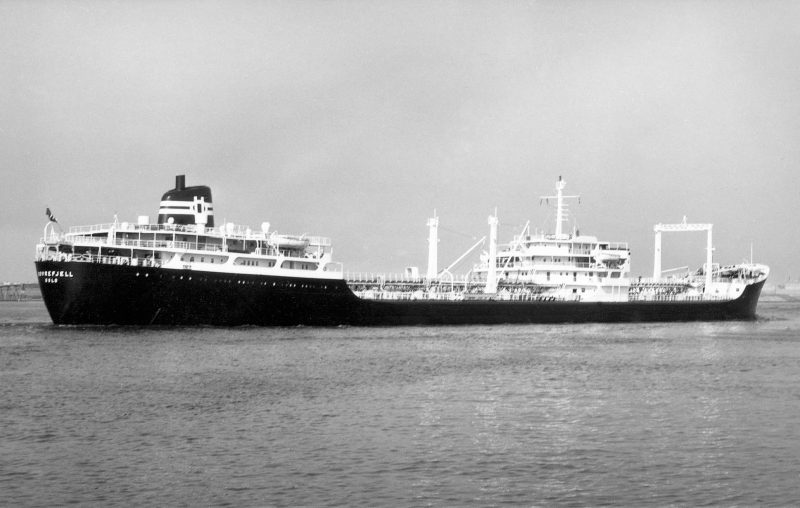
Decline Of The Fleet
The peak of the size of the fleet was thirty ships in 1960, reducing to 27 ships in 1962 and 25 ships of 662,320 dwt in 1966. Fjell Line to the St. Lawrence and the Great Lakes ceased in 1972 and all of the smaller ships of the fleet had been sold by the year end. A fleet of eight large tankers and bulkers, and five sister coastal oil and chemical tankers of 5,236 dwt in Bruce Celine, Bruce Handara, Bruce Kaete, Bruce Sally and Bruce Kimiko was being managed in 1973. The latter quintet had been completed in 1971/72 at Vegesack and featured ten separate tanks with a pumproom at each end of the cargo section. The final ships of the fleet were:-
Two seven hold bulkers of 54,190 dwt had been ordered from the Gydnia shipyard, but the first was sold to Suisse Atlantique of Switzerland before delivery and was completed as General Guisan. The second was completed as Jotunfjell and served for four years before her sale to Skaarup Shipping A/S of Norway, being renamed as Industry Trader before being sold on to Greeks in 1979 as Serrai.
A nine hold bulker of 117,950 dwt launched as Varangfjell but sold on completion in December 1973 to the Thornhope Shipping Co. Ltd. of Brighton, the British subsidiary of Norwegian shipowner Hilmar Reksten. She was taken back by Olsen & Ulgelstad on a twelve year time charter, but this charter was cancelled in 1978.
A large ore/oil carrier, Falkefjell of 234,750 dwt, owned 70% by Olsen & Ugelstad and 30% personally by Hjalmar Bjorge, a director. She was completed by the Howaldtswerke yard on 11th November 1973 on time charter to Hilmar Reksten but was laid up at Leirvik on 23rd July 1975 when Reksten became insolvent and sold off one year later.
The tanker Fagerfjell of 128,230 dwt was completed in June 1974 by the Uddevallavarvet yard in Sweden on time charter to Burmah Oil, but after six months trading was laid up at Itea in the Gulf of Corinth in Greece. She was sold after a long lay up in February 1979 to her charterer and renamed Burmah Legacy.
Postscript
Shipping was creating very little revenue for Olsen & Ugelstad at the start of 1976 due to the huge rise in oil prices by OPEC in November 1973 and consequent slump in freight rates due to little demand for oil. Fortunately, the company took delivery of a jack-up drilling rig on lucrative drilling rates to the oil majors that kept the company financially afloat for another three years. Fjelldrill was completed at Beaumont (Texas) by the Bethlehem Steel Corporation Shipbuilding Division, a yard that was noted for oil rig building and had just completed the semi-submersible rig Zapata Ugland for Zapata Ugland Drilling Inc. when the order for Fjelldrill was given. Fjelldrill had a drilling crew of sixty with a rectangular drilling platform with dimensions of 166 feet by 109 feet by sixteen feet. She had three cylindrical legs of length 275 feet and six feet thick, and featured a Halliburton HT400 cementing unit, two cranes of 52 tonnes capacity at thirty feet working radius, hydraulic jacking, a heliport, anchors with 860 feet of chain, a lifeboat for sixty persons, five Caterpillar diesels of 6,250 bhp, four generators and two water distillers. She had working limits of 250 feet of water, drilling oil wells down to 25,000 feet on sites in the Gulf of Mexico.
Unfortunately, by February 1979, the drilling revenue had only delayed the inevitable, and the last ship in the famous fleet of Olsen & Ugelstad had to be sold off as the partnership had become financially insolvent after a glorious period of 64 years.
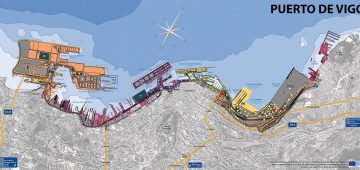



Comments
Sorry, comments are closed for this item